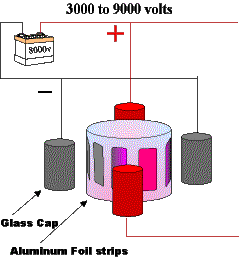 |
Terms: Leyden Jars will be referred to as
caps
STEP 1:
The 2 red caps are charged with positive voltage. The 2 dark gray caps
are at earth potential or ground. The 2 rotor aluminum strips accept the
positive charge by a brush, or a small thin piece of aluminum going from
the red caps to the rotor. The same happens on the negative side or black
caps.
My motor used 8 field caps. The drawing if for simplicity.
|
 |
STEP 2:
Because unlike charges attract, the red tabs on the rotor will approach
the negative cap and the black tabs on the rotor will approach the positive
or red caps. This causes the rotor to turn, in this case, counter clockwise. |
 |
STEP 3:
The magnetism between the rotor tabs and the field caps keep the rotor
turning. The field cap will always be the opposite polarity of the approaching
rotor tab. Every time a rotor tab passes the field cap, it's polarity changes,
keeping the rotor turning.
|
 |
STEP 4:
When the charged tab (red) gets close enough to the black cap, the foil
will touch the tab and the tab will become negative and therefore continue
to approach the positive (red) cap. This completes the cycle.
You can add as many caps as you have room for. For every additional
PAIR of caps, you increase the power greatly without greatly increasing
the load on the static generator. The closer you put the tabs, without
arcing, and more field caps you have, the more power you will generate.
|
|
POP bottle
motor.
|
CREDITS: I got the idea from Bill
Beaty's WEIRD SCIENCE. |




